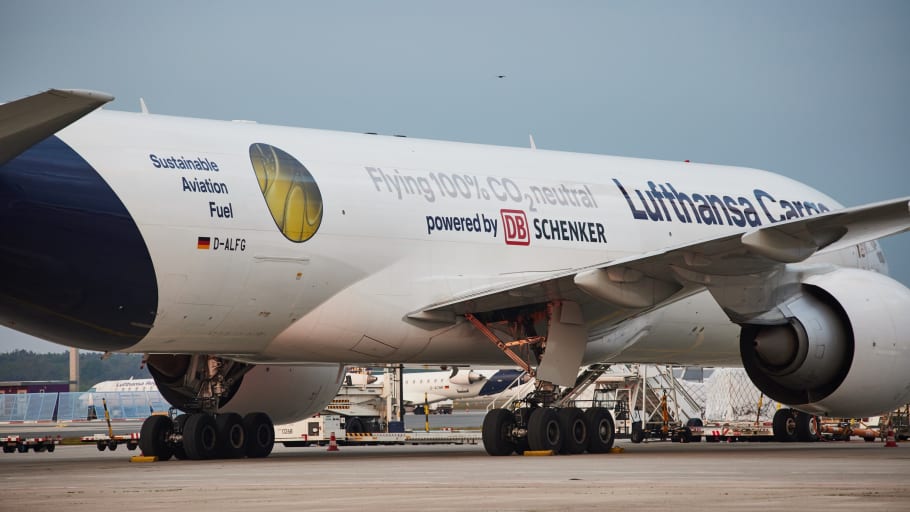Lufthansa Cargo: Laying foundations for the future
06 / 07 / 2021

Dorothea von Boxberg Credit: Lufthansa Cargo
Under new leadership of Dorothea von Boxberg, Lufthansa Cargo is future-proofing its business with sustainable solutions and an increased focus on digital.
Dorothea von Boxberg became chief executive at Lufthansa Cargo in March and has been keeping busy ever since.
During her first few months in the role, she has been focussing her attention on the carrier’s future, as well as how it can be an attractive partner to its customers.
She succeeds Peter Gerber, who left the company after nearly 30 years of service to take over at Brussels Airlines.
Asked about her strategy for the company, von Boxberg says: “We want to improve customer experience, innovate for airfreight and offer more sustainable solutions. Those are the three things that we want to do for and around our customers.
She adds: “In addition, we need to look into how we can be even more of an attractive employer and explore what we can do when collaborating with our staff and colleagues.”
She also considers infrastructure, questioning: “Do need more investment in the air – on the ground and in IT?”
Sustainable solutions
Von Boxberg says that although sustainability has been a concern in the air cargo sector for a long time, it hadn’t “taken off” until recently.
“It seems to be the topic that customers are really concerned about at the moment. They want to know what options are available,” she says.
Von Boxberg says Lufthansa Cargo is actively looking to reduce its carbon footprint.
“Around 95% of our carbon footprint stems from flying. We’re looking into how we can use as little kerosene as possible,” she says.
She outlines the carrier’s AeroShark initiative – a new film added to aircraft exterior, which makes them more aerodynamic and thus helps save fuel.
The AeroShark film was developed by Lufthansa Technik and BASF. It consists of riblets measuring around 50 micrometres and optimises the aerodynamics on flow-related parts of the aircraft.
The film will be added to the carrier’s freighters from the beginning of 2022.
Lufthansa Technik estimates a drag reduction of more than 1% for the fleet, which translates to annual savings of around 3,700 tonnes of kerosene and just under 11,700 tonnes of CO2 emissions – the equivalent of 48 individual flights from Frankfurt to Shanghai.
Von Boxberg adds: “We’ve got similar initiatives around weight: so having lightweight containers and thinking about what we can do to avoid weight that doesn’t need to be transported.”
Additionally, the carrier’s pilots continue to forecast how much fuel they’ll need for each flight, to prevent overfilling tanks.
Von Boxberg is quick to point out that these solutions seek to reduce the use of fuel – “but of course, we still need fuel” she says.
“Electric airplanes are not realistic,” she says. “I don’t think they will ever be realistic for long-range and high-tonnage freight flights. The question is, what can we do about it?
“We can either compensate, for example, planting some forests; or we can try and take some CO2 out of the air before even flying. This is an option that works with sustainable aviation fuel (SAF). That is an area that we’re really focussing on.”
Indeed, late last year, the carrier teamed up with DB Schenker to carry out the first ever CO2-neutral freighter flights, powered by SAF.
Goods from Siemens Healthineers and other companies were transported on the Boeing 777 flight from Frankfurt to Shanghai.
Since then, the two companies have launched a regular CO2-neutral freighter route, operating between Frankfurt and Shanghai.
Fuel requirements on the Boeing 777 flights are covered by SAF, which the companies say will save around 174 tonnes of conventional kerosene each week.
A maximum mix of 50% SAF is allowed to be used on a flight, but airlines get around this problem by covering the flights from a centralised pool of SAF from their overall jet fuel procurement.
Although the use of SAF in the air cargo sector is promising, there are limitations, as von Boxberg observes.
“The problem is that SAFs don’t exist in large quantities,” she says. “You’ve got a little bit of biofuel that you can buy; there’s innovative solutions to get more of it in the future, but it’s not proven in large-scale refineries or production units. That’s what we need.
“We [as an industry] also need to have discussions with oil companies and politicians; people who can help to get this industry started off.
“Currently it’s a solution that is in its infancy and it has some growing up to do.”
Conquering capacity
Like the majority of airlines during and since the pandemic, Lufthansa Cargo experienced a shortage in bellyhold capacity when passenger services were disrupted due to travel restrictions.
Yet as the air cargo industry continues to recover from the crisis and the global rollout of vaccines continues, von Boxberg remains positive.
She says: “We’ve been flying as much as we can. As you know, demand for air cargo is really high and that’s due to the lack of capacity that we’re experiencing because a lot of our long-haul passenger aircraft are still on the ground.
“I think we’re now at a point where we can be quite optimistic about it coming back sooner rather than later.
“If you look at the progress of vaccinations in different locations, as well as the easing of complications with travel restrictions in some places, the easier it gets for people to travel then the more passengers will come back and we really look forward to getting our bellyhold capacity back.”
Asked about the recovery path for Lufthansa Cargo’s bellyhold cargo capacity, von Boxberg says: “It’s always been there to a certain extent, but it’s really picking up. In this quarter [March to June 2021], it’s still coming back a bit and in the third quarter we expect it to come back a lot more. I suspect that’s true for other airlines as well.”
Lufthansa Cargo orders another B777 freighter
Lufthansa Cargo starts work on ArtCube facility at Frankfurt Airport
Lufthansa Cargo expects a good 2021 and rates to ease in H2
During this recovery period, von Boxberg says there is still a big need for “flexibility and understanding”.
She explains: “Of course, we try to support our passenger colleagues by filling the bellyholds very well and making it viable for them to fly to more destinations.
“We also still have some cargo-only passenger flights running at the moment.”
She highlights that some routes are still heavily disrupted by the effects of the pandemic and this is considered when addressing and adding capacity.
“For example, [coronavirus] is a big issue in India at the moment,” she says. “This means our crews can’t have their layover there, so how can we still serve India? There are a lot of these operational questions that we have to answer.”
Meanwhile, Lufthansa Cargo’s freighter capacity continues to grow, along with its fleet renewal.
Von Boxberg says: “We’re moving towards having a pure Boeing 777 fleet in the fourth quarter.”
The carrier is set to take delivery of its fifteenth Boeing 777 freighter aircraft – four as part of its AeroLogic joint venture with DHL – before the end of this year.
The new, twin-engine aircraft has a standard payload capacity of 103 tonnes and a range of more than 9,000 km.
Keeping in line with the carrier’s sustainability efforts, the aircraft type is more fuel efficient and quieter than previous models powered by operated three or four engines.
The carrier retired three of its MD-11Fs last year and delayed the retirement of its other MD-11Fs to secure cargo capacity at the onset of the pandemic.
Driving digitalisation
Von Boxberg says that digitalisation is a “more longstanding topic” that the carrier is addressing, but “the pandemic has given it a big boost”.
“People are seeing the benefits of not seeing people in-person, or not being able to see people in-person and then doing things digitally,” she says. “We’ve seen a lot of uptake in our digital interfaces and people are using them a lot.”
When asked what Lufthansa Cargo’s digitalisation path looks like, von Boxberg says: “It’s hard to say what exactly it will be, but we will make our user interface better in our e-booking system to offer customers our information wherever they want to see it.
“So that could be an online marketplace, such as cargo.one, or it could be a direct link into the forwarders’ transport management systems if the customer prefers putting in the effort to connect directly with us. The idea is really wherever you would like us to be for you, we would like to be present and give you that information.”She adds: “Next, of course, it’s about making our air cargo processes easier and avoiding paper – not just for air waybills but also for all kinds of other documents like veterinary and customs documents.”
Looking forward
“We see a lot of good indications that demand will remain high,” von Boxberg observes.
This is, she says, partly because airfreight is seen by suppliers as a reliable means for transporting goods when supply chains are disrupted.
She gives the example of recent disruption to seafreight capacity; for automotive and other time-sensitive industries, airfreight is often sought after as a solution to prevent or minimise delays.
Other drivers of airfreight demand are e-commerce growth and the effects of the pandemic.
Noting the increasing reliance on e-commerce, she says: “People are so used to – and find it so convenient – to do their shopping online now.
“I think customers just don’t realise where their goods are sourced from. They think ‘it’s just a click away’ and they assume it’s coming from somewhere close by, but on some occasions they may wonder why the delivery is taking so long. That’s because it could be coming from somewhere as far as China.”
On the need for pandemic-related supplies, she says: “There is huge demand on the pharma side. Vaccine are being flown into lots of countries that don’t produce them, or that are not close enough to airports to be served by road feeder services.”
She observes that many countries in Europe are receiving vaccines by road, whereas some countries located in Africa South Asia and Southeast Asia, are reliant on airfreight to bring the vaccines in.
With recovery from the pandemic in sight and e-commerce growth showing no signs of slowing down, what does the ‘new normal’ for the airfreight sector look like?
Von Boxberg says it’s difficult to tell “because airfreight is so short-lived and customers tend to book around seven days in advance”.
However, she adds: “Looking at the bigger picture from 30,000 ft, I think capacity will be tighter than demand for a long time. But we all know that airfreight trends are never steadily positive. I don’t know exactly when there will be a downturn in the next five years, but there will be one for sure.”















